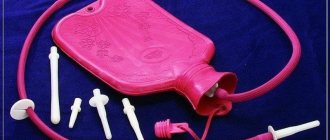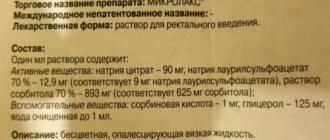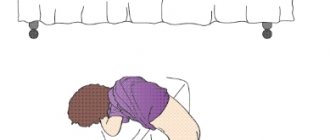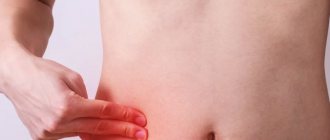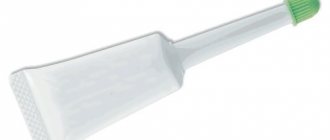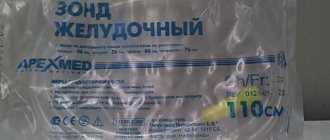home
/
Articles
/
Enema: types, indications and features of the procedure
An enema is a medical procedure in which medications or liquids needed by the patient are introduced into the colon using special devices (tubes with special tips, special syringes and bulbs). They help cleanse the intestines of feces, relieve the body of intoxication, improve peristalsis of organs, and promote proper blood circulation in the pelvic organs. Enemas are also used in the treatment of more complex diseases, when it is necessary to introduce medicinal substances into the patient’s body, and traditional methods are not so effective.
Despite the large list of positive properties of this procedure, you should not abuse it, and before doing an enema yourself, you need to make sure of its necessity by consulting a doctor.
Medicinal enema, placement algorithm
Medicinal enemas are divided into local-action enemas (micro-enemas) and general-action (drip) enemas. Medicinal enema (microenema). Target . Providing local effects for diseases of the rectum; general (resorptive) effect on the entire body. Indications . Diseases of the rectum. Contraindications . Acute inflammation of the anus; rectal tumor; gastrointestinal bleeding. Equipment . Medicinal solution as prescribed by a doctor; Janet syringe or rubber spray; sterile rectal tube 30 cm long or catheter; sterile petroleum jelly; sterile gauze wipes; water bath, clean jar; water thermometer; oilcloth, diaper.
Enema at home
An enema is an unpleasant procedure, and therefore it is best to entrust its implementation to experienced medical professionals who know how to reduce the inevitable discomfort. If travel to a medical facility is not possible due to age or existing medical conditions, or if just the thought of an enema in a public place causes anxiety, it is quite possible to do an enema at home. However, it is worth noting that carrying out the procedure independently is accompanied by some inconveniences - it is difficult to find a comfortable position both for infusing liquid and for holding it, it is difficult to regulate the flow of liquid and it is almost impossible to change the height of the container if necessary. The most effective way is to call a nurse at home who knows how to properly administer an enema. A qualified nurse will ensure that the procedure is not done forcefully, which often happens when performed independently, and will quickly reduce the fluid pressure if the patient experiences the slightest pain. In addition, an experienced nurse will create a favorable psychological environment, relieving the patient of feelings of embarrassment. Do not forget that an enema is a medical procedure, which can only be performed as prescribed by a doctor. Abuse of enemas leads to disruption of the intestinal microflora and further disruption of its daily function.
< back to list
Administration of a medicinal enema (microclyster):
1. The patient is warned about the upcoming procedure. Since you need to lie down after it, it is better to give the enema at night in the ward. 2. 30 - 40 minutes before administering a medicinal microenema, a cleansing enema is given. 3. The medicine in the indicated dose is poured into a clean jar and heated in a water bath to a temperature of +37...+38°C. 4. Take the medicine (50 - 200 ml), heated in a water bath, into a Janet syringe or rubber balloon. 5. Place an oilcloth under the patient, then a diaper and ask him to lie on his left side, pulling his legs, bent at the knees, towards his stomach. 6. A rectal tube (or catheter) is inserted into the rectum with a 20 cm rotational movement and connected to a Janet syringe (or balloon). 7. Slowly inject the medicine into the rectum in jerks. 8. Having finished the insertion, clamp the tube with your fingers, remove the syringe, draw a little air into it, connect the syringe to the tube again and, releasing the air from it, push it! remaining medication from the tube into the intestines. 9. Remove the syringe, clamp the tube, and carefully remove the tube from the rectum using rotational movements. 10. The patient is advised to take a comfortable position and not stand up.
Medicinal enema, technique of execution.
Notes . To avoid irritation of the rectal wall and the urge to defecate, the concentration of the drug should be hypertonic. The medicine should be administered in small volumes. The medicine must be heated. After use, the rectal tube is soaked in a 3% chloramine solution for 1 hour. If a catheter is used instead of a rectal tube, it should be labeled and used only for insertion into the rectum. The manipulation should be performed with rubber gloves.
Cleansing enema: what is special and in what cases is it effective?
The main task of a cleansing enema is to liquefy and then remove the contents from the colon, namely its lower segments. As a rule, it is effective during prolonged difficulty in defecation, during the treatment of poisoning and intoxication of the body. Experts also prescribe this procedure as a preparatory stage for various operations, childbirth, endoscopy of the colon or x-ray of the digestive tract. This medicinal type procedure is often used before medicinal administration.
It is not recommended for:
- the presence of inflammation in the body;
- development of erosive-ulcerative type formations on the inner lining of the large intestine;
- acute appendicitis and peritonitis;
- other pathologies of the abdominal cavity in the active stage;
- heart failure syndrome;
- when blood leaves the channel in the gastrointestinal tract.
Departure is paid separately - from 550 rubles
Request a call
Call:
+7 (499) 455-08-05
You should also not prescribe an enema to patients who are in the early postoperative recovery stage. In any case, you need to visit a specialist and make sure that there are no contraindications, and the enema will only have a positive effect. To avoid negative consequences, carry out the procedure under the supervision of a doctor or entrust it to a nurse.
Drip enema.
Target . Drip enemas are given for therapeutic and nutritional purposes. Indications . Large loss of blood or fluid; artificial nutrition through the rectum. Contraindications . Acute inflammation of the anus; rectal tumors; gastrointestinal bleeding. Equipment . Sterile system for drip administration of liquids for single or multiple use; a bottle with a medicinal solution or flask; sterile rectal tube 30 cm long or catheter; water bath; heating pad with warm water (+40…+42 °C); lining oilcloth, diaper; Vaseline oil; gauze napkin; water thermometer; latex gloves.
Types of enemas
Of course, enemas are different in their structure and content, since they are used for various diseases. Only a qualified doctor can prescribe the correct option after studying the medical record, but before doing an enema at home or in the hospital, everyone should familiarize themselves with what they are.
Departure is paid separately - from 550 rubles
Request a call
Call:
+7 (499) 455-08-05
Oil enemas
They are usually prescribed for prolonged constipations, usually of spastic origin. Instead of water, use 0.1-0.2 grams of liquid vegetable oil. Any is suitable, it is important to heat it to 38°C. It is immersed in the intestine using a syringe, as well as a rubber bulb. Their effect is that, thanks to the soft enveloping effect, the walls relax, which has a positive effect on intestinal motility. The result appears after 10-12 hours, so it is better to use the enema in the evening, after lying down for at least half an hour after the procedure.
Hypertensive enemas
Hypertonic enemas are a saline solution that can be obtained in several ways:
- 0.05 to 0.1 l sodium salt of hydrochloric acid 10%;
- 0.05 to 0.1 l magnesium sulfate 20-30%.
It is also not recommended to have a bowel movement for about half an hour. This type of enema has been proven effective in the fight against edema, such as meningeal edema, since this concentration of salt activates the release of fluid into the intestine.
Siphon enemas
They are quite popular in patients with eating disorders, intoxications, metabolic disorders, and also in cases where other types of procedures have not produced results. It is worth remembering that the use of this type of device is especially dangerous for certain diseases, so you should not prescribe this procedure yourself.
For this type of enemas, a large funnel is used, the volume of which can reach 2 liters, as well as a rubber tube and nozzle. The funnel can be filled with a simple warm liquid, non-concentrated potassium permanganate, or a 2% baking soda solution. The funnel is also placed above the patient approximately 50 cm, slightly tilted. When most of the liquid enters the body and reaches the narrowing in the funnel, it will be necessary to lower the device below the couch. It will immediately fill with liquid flowing in the opposite direction, mixed with gases and feces. The filling of the device is poured out and the procedure is carried out until the water runs out and is clear. This may require about 10-12 liters of liquid.
Drip enemas
This method is used in cases of dehydration, in cases where it is necessary to administer a large amount of medicinal solutions, but this is impossible to do intravenously due to the high level of blood viscosity. This design consists of a rubber tube, a conventional dropper and a clamp. The tube is also placed at 2-3 inches, and the flow of liquid is regulated by a clamp. As a general rule, it is recommended not to exceed a rate of one hundred drops of solution/minute.
Starch enemas
These solutions are widely used for colitis to soften and relax the intestinal walls. The preparation process is simple: 5 grams of powder are dissolved in 0.1 liter of cold boiled water, and then the same amount of boiling water is gradually introduced. If necessary, you can add the necessary medications. Before administration, cool the solution to 40°C.
Nutrient enemas
Enemas of this kind help to additionally saturate the patient’s body with useful substances. Plain water is replaced with a warm glucose solution and aminocarboxylic acids. The volume of such an enema usually does not exceed 0.2 liters. The main feature of such an enema is that it can be used 3-4 times in a 24-hour period, but if there is a need to increase the dose of medications, then a drip-type enema is prescribed.
Technique of the procedure
A siphon enema is performed according to the following algorithm:
- The nurse puts on an apron and gloves, covers the couch with oilcloth, and places a basin for rinsing water. The edge of the oilcloth should hang into the basin.
- The patient frees the lower part of the body from clothing, lies on his left side, bends his knees and brings them to his stomach. The oilcloth should be under the buttocks.
- Lubricate the tip of the intestinal tube with Vaseline oil, spread the patient’s buttocks and gently rotate the tube into the rectum 30-40 cm. In this case, the funnel is located below the buttocks in an inclined position.
- Water is poured into the funnel and raised 1 meter above the level of the buttocks. Liquid begins to flow into the intestines.
- When the water level reaches the bottom of the funnel, it is lowered again. The intestinal contents fill the funnel. The washing liquid is poured into a basin, and the funnel is filled again with clean water. In case of poisoning, the first portion of intestinal contents is collected in a special container, signed and sent for analysis. The procedure is repeated until clear liquid is obtained.
- The funnel is disconnected, the end of the tube is lowered into the basin and left for 15-20 minutes for residual liquid and gases to drain.
- Slowly remove the probe.
- The enema system is disassembled and placed in a container with an antiseptic solution. The oilcloth and apron are disinfected.
- After a siphon enema, the patient needs to rest for about 2 hours.
The doctor monitors the progress of the procedure, monitors the patient’s condition, monitors the amount of fluid introduced and removed, and its nature. The absence of gas bubbles in the washing water indicates intestinal obstruction. In case of severe abdominal pain or the appearance of blood in the rinsing water, the manipulation is stopped immediately.
Read on the topic: Performing an enema using an Esmarch mug: step-by-step instructions
Contraindications
There aren't that many of them. Giving an enema is prohibited if the following are reliably diagnosed:
- Bleeding, inflammation, chronic spastic phenomena, accompanied by ulcers or erosions of the mucous membranes in the intestines
- Neoplasms in the intestines, especially when it comes to malignant tumors
- Postoperative period after surgery
- Intestinal prolapse, perforation or thrombosis
- Fissures in the anus, bleeding hemorrhoids, vascular embolism
A large volume of fluid entering the intestines unnaturally, in the presence of the above-described contraindications during the procedure, can aggravate the course of the disease and worsen the patient’s condition.
Preparing for an enema
A siphon enema is performed only in a hospital. The procedure is performed by a nurse in the presence of a doctor.
Patient preparation
A siphon enema is extremely unpleasant and sometimes painful. It is important to prepare the patient psychologically. The doctor explains the procedure, the meaning of it, and answers questions. Then has the patient sign informed consent.
Before the enema, you need to urinate, and during the procedure, try to relax and breathe deeply.
Read on the topic: How to give an enema using a syringe at home
Required Tools
For the procedure you will need:
- Sterile enema system. It consists of a 1.5 m long rubber tube and a glass funnel. The intestinal tube at the end has one central opening and several side ones.
- 1 liter bucket.
- Bucket or basin for rinsing water.
- Vaseline or Vaseline oil.
- Lining oilcloth.
- Robe, oilcloth apron, rubber gloves for the nurse.
- Containers with antiseptic solution.
Liquid
A siphon enema usually requires 10-12 liters of boiled water, heated to a temperature of 37-38 °C. Too cold water leads to chills, hot water causes a burn to the mucous membrane.
Indications for use
A siphon enema is a serious procedure that is traumatic for the intestines. Together with feces and toxins, beneficial microflora is washed away. Subsequently, dysbiosis may develop. Therefore, the procedure should be carried out only according to strict indications:
Medical products (drugs, medicines, vitamins, dietary supplements) are mentioned for informational purposes only. We strongly do not recommend using them without a doctor's prescription. We recommend reading: “Why can’t you take medications without a doctor’s prescription?”
- ineffectiveness of a regular cleansing enema for constipation;
- suspicion of intestinal obstruction and its conservative treatment;
- poisoning – during the procedure, toxic substances, products of rotting and fermentation are removed from the colon;
- before intestinal surgery.

